Chapter 1: Plan Overview
- No related sections.
Minnesota’s 12,000-mile state highway system plays a key role in supporting the state’s economy and quality of life. Businesses rely on the system to move their goods and raw materials throughout the state. In addition, state highways connect Minnesotans to other transportation networks and to state, national and global markets.
The Minnesota Department of Transportation is responsible for constructing, operating, and maintaining this system. The 20-Year Minnesota State Highway Investment Plan is MnDOT’s vehicle for deciding and communicating capital investment priorities for the system for the next 20 years. MnSHIP is updated every four years and was last completed in 2013. This chapter provides an overview of Minnesota’s state highway system and describes the role of MnSHIP in managing this important transportation network.
The key messages of Chapter 1 are:
- MnSHIP identifies capital investment priorities based on projected funding for Minnesota’s 12,000-mile state highway system.
- MnDOT updates MnSHIP every four years to reflect changes in policy, transportation needs and trends, and revenue.
- MnSHIP connects vision and policy direction for transportation in Minnesota to project selection on the state highway system.
- Investments on the state highway system are allocated into 14 categories that make up five investment areas: System Stewardship, Transportation Safety, Critical Connections, Healthy Communities, and Other.
The Purpose of MnSHIP
- Chapter 2 - Revenue Forecast
- Chapter 2 - Federal Law
- Chapter 2 - State Requirement
- Chapter 2 - MnDOT Policy
- Chapter 2 - Current System Conditions
- Appendix F (coming soon)
- Appendix G
MnSHIP directs capital investment for Minnesota’s state highway system. The plan must identify investment priorities given current and expected funding. It is updated every four years, as required by the Minnesota statute. This MnSHIP update spans the 20-year planning period from 2018 to 2037.
MnDOT takes into account many factors in developing MnSHIP. The plan prioritizes future investments to address the widening gap between highway revenues and construction costs. MnSHIP also considers federal and state laws, MnDOT policy, and current and expected future conditions on the state highway system. These factors are described in more detail in Chapter 2: Key Factors and Assumptions.
MnSHIP describes how MnDOT will use capital investments to repair, replace and improve the state highway system. The plan does not address how MnDOT funds the operation of the system or day-to-day maintenance. While decisions made in MnSHIP can clearly affect the operations and maintenance of the system, MnDOT is only in the beginning stages of explaining these impacts more effectively. This MnSHIP update starts to show how the lack of revenue for construction projects affects the experience of the user as well as MnDOT’s operations budget.
Relationship to MnDOT's Plans and Programs
MnSHIP is part of a “family of plans” that connects vision and policy direction for transportation in Minnesota to how MnDOT selects projects and makes improvements on the state highway system. The “family of plans” is shown in Figure 1-1. Together the plans serve as a framework for implementing a multimodal transportation system throughout Minnesota.
MnDOT updates the Statewide Multimodal Transportation Plan every four years. The plan describes statewide objectives and strategies that help MnDOT and its partners make progress toward the Minnesota GO 50-Year Vision. The SMTP is about more than just roadways and more than just MnDOT. However, MnDOT uses the STMP objectives and strategies to inform a number of modal and system plans. These plans include MnSHIP as well as the State Aviation System Plan, the Statewide Bicycle System Plan, the Statewide Freight System Plan, the Statewide Ports & Waterways Plan, the State Rail Plan, the Greater Minnesota Transit Investment Plan, the Statewide Pedestrian Plan and a collection of supporting plans. These modal and system plans are updated every four to six years. Some help to set specific investment direction, others focus more on general policy guidance, and some do both.
MnSHIP is a system investment plan because it sets investment direction for the state highway system. MnDOT has used performance-based planning to develop MnSHIP for more than 10 years. As a performance-based plan, MnSHIP uses measures and targets to assess system performance, identify needs, and develop investment priorities. Since MnSHIP is limited to existing and projected funding, the need for investments to be driven by performance-based criteria is increased. MnSHIP links policies and objectives in the Minnesota GO 50-Year Vision and the Statewide Multimodal Transportation Plan with capital investments on the state highway system.
Figure 1-1: Family of Plans
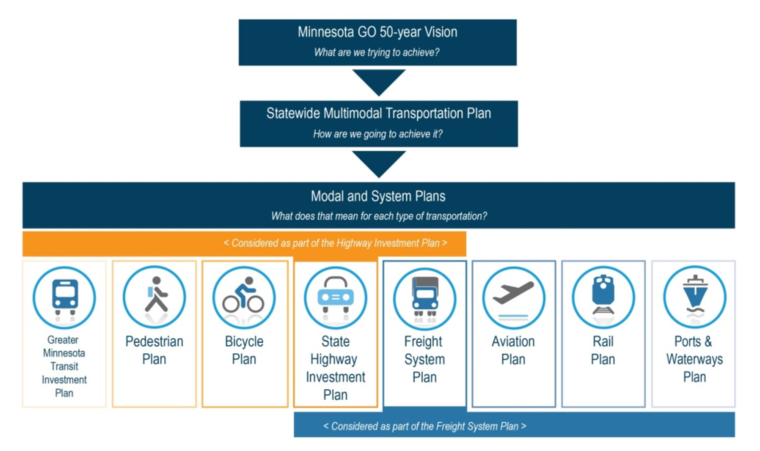
Relationship of MnSHIP Investment Direction to Project Selection
Guided by the Minnesota GO Vision and the Statewide Multimodal Transportation Plan, MnSHIP’s investment priorities are set through an extensive planning process.
At the beginning of this process, technical work groups met to discuss current and projected conditions for state highways. MnDOT used performance measures and technical expertise to evaluate how different highway investments might advance the Minnesota GO Vision and the Statewide Multimodal Transportation Plan as well as system performance targets. MnDOT developed alternative investment approaches to solicit input from the public, local government transportation officials and MnDOT staff on investment priorities. MnDOT used this input to set the investment direction for the state highway system for the next 20 years.
MnDOT’s districts select projects that follow the MnSHIP investment direction and help make progress toward MnDOT goals and objectives. These projects are presented in the 10-Year Capital Highway Investment Plan. The first four years of the CHIP make up the State Transportation Improvement Program. Projects in the STIP are well-defined and typically considered a commitment. The projects identified in the final six years of the CHIP are not commitments because they are anticipated to change as project development progresses and needs are better understood. The CHIP is updated annually to address new project-level information as well as infrastructure conditions and system performance. MnDOT districts are responsible for designing, delivering and constructing selected projects.
MnDOT districts work closely with a broad range of stakeholders through Area Transportation Partnerships. These partnerships provide a collaborative decision-making process for the selection of local projects that are recommended to receive federal funds. In addition, ATPs provide a local perspective on the district’s list of programmed projects in the STIP.
Projects are implemented annually through the STIP, which documents the projects that MnDOT will fund and deliver over the upcoming four years. Annual updates of the STIP allow MnDOT to make timely changes that incorporate new investment decisions based on new plan strategies, investment priorities or system performance. MnDOT’s high-level project selection process is shown in Figure 1-2 and further information on project selection can be found in Chapter 5: Investment Direction and Appendix E: Financial Summary.
Figure 1-2: Policy to Projects
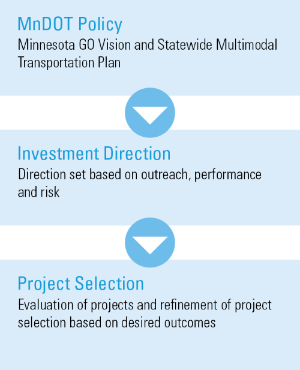
Organization of Chapters
The chapters in this plan are based on the steps in the plan’s development process, presented together in Figure 1-3. The first step in the MnSHIP planning process involves gathering information from various sources. Chapter 2: Key Factors and Assumptions covers the state and federal legislative requirements for MnSHIP as well as current system conditions and revenue available for the plan. Chapter 3: Investment Needs describes the amount of money needed to meet performance targets and key objectives for each investment category.
The second step in the MnSHIP process involves developing investment scenarios and selecting a preferred scenario. Three scenarios were developed and presented to the public and transportation stakeholders during public outreach. The details of this process are described in Chapter 4: Development of Investment Direction.
The third step in the MnSHIP planning process is setting the investment direction. Once the results from public outreach were analyzed, MnDOT gathered input from internal staff and developed an investment direction for MnSHIP. This direction describes how MnDOT is going to invest in the state highway system for the next 20 years. The details of this investment direction are presented in Chapter 5: Investment Direction.
Figure 1-3: MnSHIP Chapters and Development Process
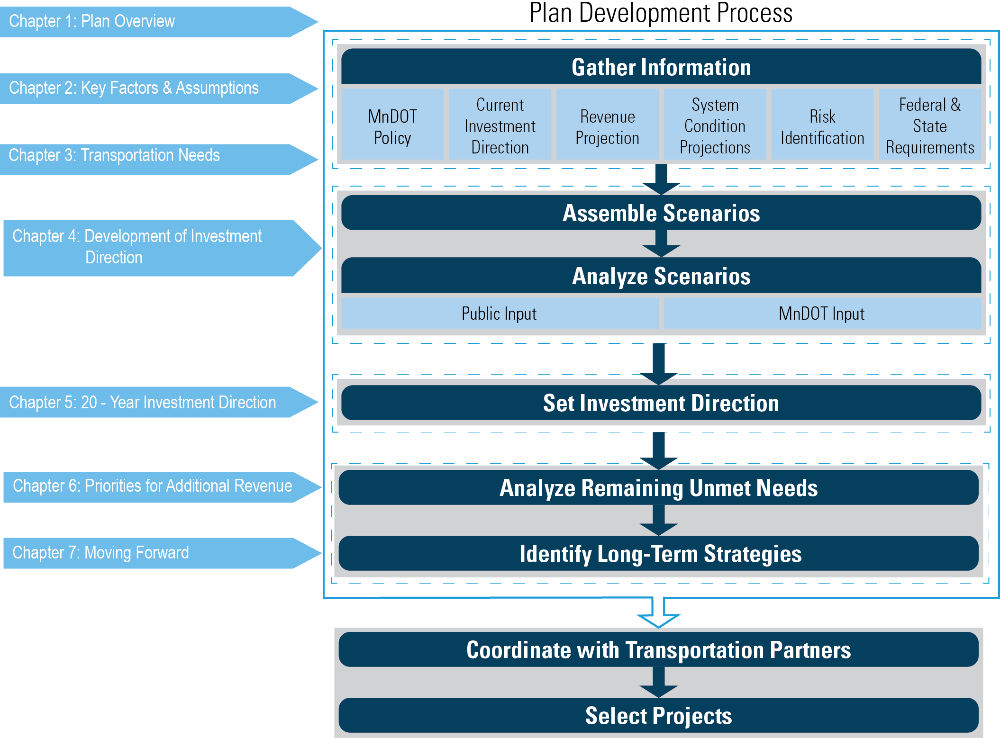
The fourth step in the MnSHIP process is assessing the impacts and outcomes of the investment direction. Chapter 6: Priorities for Additional Revenue identifies gaps between the MnSHIP investment direction and desired outcomes; it identifies priorities for investment should additional revenue be made available. Chapter 7: Moving Forward identifies strategies to maximize the benefits of MnDOT’s investment on the state highway system.
Once MnSHIP is complete, MnDOT districts select projects that follow the investment direction and strategies established in the plan. These planned and programmed projects are presented in the 10-Year CHIP.
Minnesota’s State Highway System
- No related sections.
The state highway system is a multimodal network serving many different transportation users. These users include motorists, freight carriers, transit passengers, bicyclists and pedestrians. It also connects these users to other transportation systems, such as transit networks, rail, aviation and waterways, as well as county and city roads.
The importance of the state highway system is demonstrated by its use. At 12,000 miles, the system comprises only 8 percent of Minnesota’s total roadway miles, yet carries almost 60 percent of the vehicle miles traveled and moves the majority of freight. State highways are central to many communities in Minnesota and their conditions directly affect residents’ quality of life.
A strong economy depends upon a well-maintained and well-connected transportation network. Minnesota businesses rely on the state highway system’s size, connections and pavement and bridge conditions to carry freight throughout the state. To keep Minnesota economically strong into the future, MnDOT needs to maintain and improve the state highway system. The size and the age of Minnesota’s transportation system demonstrate the scope of the state highway system’s investment need:
- 50 percent of state highway pavements are more than 50 years old
- 40 percent of state highway bridges are more than 40 years old
- Minnesota ranks in the bottom half nationally for interstate pavement condition (33rd out of 50)[1]
- Minnesota ranks 13th nationally for bridge condition on state highways[2]
Which Roads Make up the State Highway System?
The state highway system includes all Interstate highways, U.S. highways and Minnesota state highways. These roads fall into two categories: National Highway System roadways and non-NHS roadways. NHS roadways serve statewide and interstate travel and are the primary connections between large urban areas throughout the state and beyond. Non-NHS state highways provide important connections for regional and local travel and generally carry lower traffic volumes. Figure 1-4 shows the extent of the state highway system.
Figure 1-4: Minnesota's State Highway Network
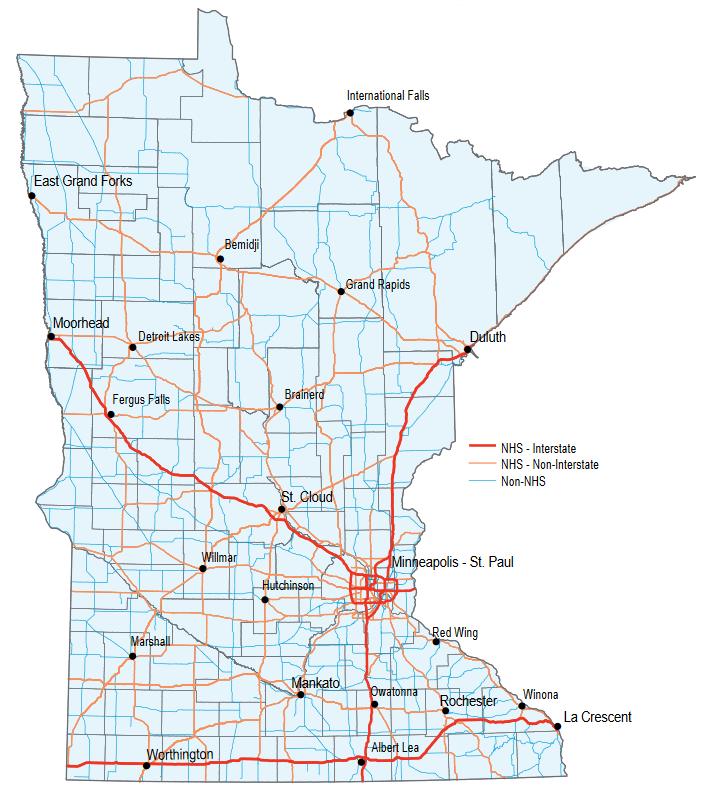
MnDOT’S Organization and Management of the State Highway System
State highway construction and maintenance responsibilities are divided into eight MnDOT districts. Figure 1-5 maps the district boundaries. MnDOT’s Central Office headquarters are located in St. Paul, near the state Capitol building.
Figure 1-5: MnDOT District Boundaries and their Headquarters
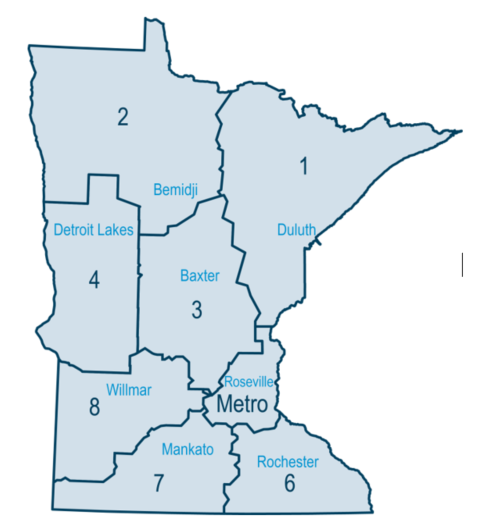
What Trends Are Influencing Transportation?
The Minnesota GO 50-Year Statewide Vision and the Statewide Multimodal Transportation Plan identify challenges and opportunities facing Minnesota’s transportation. Because transportation infrastructure can last up to 50 years or longer, it is important for MnDOT to monitor trends that influence the use and condition of the state’s transportation system. This allows MnDOT to adapt roadway designs and operations as needed. Included in these considerations are:
- Minnesota’s aging population. Minnesota’s population as a whole will age significantly in the next 20 years. Just less than 14 percent of Minnesotans are over the age of 65.[3] The number of seniors in Minnesota will continue to grow until hitting a peak in the year 2035. At that point there are projected to be more than 1.2 million seniors in Minnesota (20 percent of Minnesotans). In 2035, for the first time, more Minnesotans will be older than 65 than under 18.
- More Minnesotans living in urban settings. Minnesota is becoming more urban in all parts of the state. Just over 70 percent of residents lived in urban areas with more than 2,500 people.[4] The number of people living in rural areas has stayed fairly level since 1900. Minnesota’s urban population has grown during the same time. The State Demographer projects most Minnesota counties will grow in population over the next 30 years. The largest population growth is projected to occur in the Twin Cities region, with a smaller rate of growth in Greater Minnesota’s urban communities.
- Aging Infrastructure. Minnesota faces a wave of aging pavements and bridges that are in need of maintenance or reconstruction. MnDOT typically reconstructs roadways when they are between 60 and 70 years old. Bridge replacement typically occurs at 70 to 80 years old. Additional needs for maintenance can be found on Minnesota’s airports, railroads, ports, and waterways. These needs add to a seemingly ever-growing list of investments that must be made to maintain the quality of the state’s public systems.
- New technology and mobility as a service. New companies and technologies have made people re-think how they travel, especially in urban areas. Mobility as a service offers new options to use the system through the “sharing economy.” One example of mobility as a service is car sharing, which is available through companies like Zipcar in the Twin Cities, Mankato, and Winona. Other ride matching services like Uber and Lyft have seen rapid growth in recent years. Self-driving vehicles are emerging rapidly and have the potential to dramatically change the way society travels.
- Climate change. Climate change is already having major impacts in Minnesota and will continue to have impacts into the future. What these impacts will be is not always clear. More varied temperatures, precipitation levels and frequency of extreme weather events will stress the transportation system. It is possible that these changes could increase maintenance costs and affect the way that Minnesotans travel.
- Persistent budget challenges. In the face of transportation funding challenges (discussed in detail in Chapter 2: Key Factors and Assumptions), MnDOT and its partners are placing more focus on innovative design, shared services and other collaborative solutions to address and prioritize transportation needs.
Investment Category Descriptions
- Chapter 2 - Current System Conditions
- Chapter 3 - Summary of Needs
- Chapter 5 - Investment Summary
- Chapter 6 - Unmet Needss
- Appendix I
MnDOT invests in the state highway system through various types of capital improvement projects. Some projects enhance the condition of existing infrastructure, whereas others add new infrastructure to the system. Investment categories are components of projects. A single MnDOT project can include investment from multiple different investment categories. There are many competing priorities for investment along the state highway system. MnDOT is responsible for selecting investments that best balance these priorities. This is especially challenging given the widening gap between MnDOT’s projected transportation revenues and investment needs.
MnDOT tracks capital investment in highways by investment categories. The 2013 version of MnSHIP identified 10 investment categories. This MnSHIP update includes four additional investment categories. The individual categories are separated into five major investment objective areas as illustrated in Figure 1-6.
| System Stewardship | Transportation Safety | Critical Connections | Healthy Communities | Other |
|---|---|---|---|---|
|
|
|
|
|
System Stewardship: Category Descriptions
System Stewardship includes five investment categories: Pavement Condition, Bridge Condition, Roadside Infrastructure Condition, Facilities and Jurisdictional Transfer.
Pavement Condition
MnDOT preserves the structural integrity and smoothness of its pavements through investment in the Pavement Condition category. MnDOT seeks to maximize the share of state highway pavement in good condition and minimize the share in poor condition. This category includes the repair or replacement of existing pavement on the state highway system. Typical improvements to pavements include:
- Overlays – Putting new pavement on top of old pavement to smooth the road surface
- Mill and overlays – Removing a few inches of the existing pavement and then putting new pavement on top
- Reconstruction projects – Completely rebuilding the road and the road base
MnDOT’s largest and most widely used asset is its pavements. On an average day, there are more than 90 million vehicle miles traveled on Minnesota state highways. Most new pavements last approximately 15 to 30 years before deteriorating to a level that requires repair. Once pavements fall into poor condition, the costs to fully repair them increase significantly. As a result, larger capital investments are necessary on poor condition roadways if MnDOT wants to restore them to smooth pavement conditions.
Bridge Condition
The Bridge Condition category includes the repair or replacement of existing bridges on the state highway system. Construction of new bridges on the state system is also included in this category. Typical bridge improvements include replacement, rehabilitation, and painting. The Bridge Condition category does not include surrounding or supporting elements for bridges, such as signs, pavement markings or lighting.
More than 4,500 of Minnesota’s 20,000 bridges are on the state highway system and are maintained by MnDOT. Most bridges last 70 to 80 years before needing replacement, if maintained regularly. By planning bridge investments in a timely and cost-effective manner, MnDOT is able to maintain these vital connections.
Roadside Infrastructure Condition
Roadside Infrastructure Condition includes an array of supporting infrastructure found on the state highway system. This infrastructure enhances the safe, informed and efficient movement of people and goods throughout the state.
Roadside infrastructure elements include:
- Drainage and culverts that carry water away from or under the road
- Guardrails, including cable-median barriers, and fencing that protect people and infrastructure
- Traffic signals, lighting and Intelligent Transportation Systems that enhance safety and provide information
- Overhead signs and other structures, such as noise walls, retaining walls, and concrete barriers
- Signage, including traffic and directional signs
- Pavement markings
Roadside infrastructure improvements are often completed with a pavement or bridge project. MnDOT also conducts stand-alone projects, such as culvert replacement projects along segments of road with poor drainage or culverts.
Facilities
The Facilities investment category is a new category in this MnSHIP update. It includes the repair and maintenance of existing state highway rest areas and truck weigh stations. This category does not include buildings such as district headquarters, truck garages or other operational buildings.
Rest areas serve as a refuge for drowsy drivers, support freight movement and promote state and regional tourism. By providing adequate and properly spaced rest areas along the state highway network, MnDOT can meet the demand and expectations of the traveling public. Weight enforcement conducted at weigh stations ensure that freight being shipped to and through Minnesota is not overweight. Enforcement of Minnesota’s truck size and weight laws increases safety and reduces damage to roadways and bridges.
Jurisdictional Transfer
Jurisdictional Transfer is a new investment category for this update of MnSHIP. It includes the costs associated with transferring ownership of a road to or from MnDOT. There is significant cost to complete jurisdictional transfers because roads are typically improved before they are transferred. When an agency has jurisdiction of a street or highway, that agency is responsible for the upkeep of that facility. These responsibilities remain with the agency until the jurisdiction is transferred to another roadway authority.
The objective of Jurisdictional Transfer is to ensure that Minnesota roads are owned and operated by the right level of government. Jurisdictional transfer is important because properly aligned roads provide the right level of service, and better meet customer expectations for maintenance, ride quality and safety. Roads that are a low priority for one agency may be a higher priority for another agency. Jurisdictional transfer allows for a better alignment of roadway ownership with agencies’ priorities.
Transportation Safety: Category Descriptions
Traveler Safety
The Traveler Safety category includes investments in new highway safety improvements. Typical improvements include lower cost, high-benefit engineering solutions, such as rumble stripes, lighting, signage and new cable median barriers. MnDOT also invests in higher-cost treatments, such as signals and reduced conflict intersections (e.g. roundabouts, median refuges and reduced crossing u-turns). These higher-cost improvements are used to address sustained crash locations.
Vehicle crashes are the leading cause of death for people under the age of 25 and the fourth leading cause of death overall in the nation. Crash-related deaths and serious injuries create significant costs for individuals, families and society. On average, more than one person died every day in 2015 on Minnesota roads (411 total) and more than three were seriously injured. MnDOT and its partners have made reducing fatalities and serious injuries a top priority through:
- The Toward Zero Deaths initiative. MnDOT and its partners use a data-driven, multi-disciplinary “four Es” approach – education, engineering, enforcement and emergency services – to target and reduce fatalities and serious injuries. By implementing the TZD[5] approach, the state of Minnesota has seen a dramatic decline in traffic fatalities during the past decade.
- Proactive lower cost, high-benefit safety features. Lower cost safety improvements may be newly installed as part of a pavement project, including edge treatments (rumble stripes and rumble strips), guardrail and pavement markings, or as stand-alone projects. MnDOT has also developed District Safety Plans for each MnDOT district. The plans prioritize strategies at high-risk locations and identify appropriate treatments that are proven to reduce fatal and serious injury crashes.
- Improvements at sustained crash locations. These are locations with a consistently high-crash rate over a five-year period compared to similar locations across the state. Improvements at these locations tend to be higher-cost intersection improvements and can be targeted for motorized and non-motorized modes. Projects in this category include improvements such as roundabouts and passing lanes.
- Railway-Highways Crossings. Traveler Safety funding is also used to address at-grade railway-highway crossings. Funding can be used for signal upgrades, crossing closures and consolidations, removal of visual obstructions and roadway geometrics and grades.
Critical Connections: Category Descriptions
There are five categories in which MnDOT invests to improve transportation connections: Twin Cities Mobility, Greater Minnesota Mobility, Bicycle Infrastructure, Accessible Pedestrian Infrastructure, and Freight. These investment categories comprise the Critical Connections investment area.
Twin Cities Mobility
The Twin Cities Mobility investment category includes projects to improve travel time reliability in the Twin Cities area. Congestion plays a major role in the daily lives of people in the Twin Cities area and is a serious and costly disruption for freight movement within and through the region. Managing congestion improves quality of life, safety and air quality. Roughly half of all roadway travel in Minnesota occurs within the Twin Cities area, which contains just 9 percent of the total roadway miles in the state. In 2015, the Metropolitan Council completed its 2040 Transportation Policy Plan. This plan continues a shift away from reliance on major highway capacity expansion projects toward lower-cost high-benefit strategies. The investment strategies for the Twin Cities Mobility category in MnSHIP align with the investment direction established in the 2040 Transportation Policy Plan, although available funding does not meet needs. Twin Cities Mobility investments include:
- Active Traffic Management. Operational improvements to help manage the effects of congestion, which include variable message signs, freeway ramp metering, dynamic signing and re-routing, dynamic shoulder lanes, reversible lanes, dynamic speed signs and lane specific signaling.
- Spot mobility improvements. Lower cost, high-benefit projects that improve traffic flow and provide bottleneck relief at spot locations. These projects include freeway and intersection geometric design changes, short auxiliary lane additions, bus-only shoulders and traffic signal modifications to ease merging and exiting traffic.
- MnPASS express lanes. Priced managed lane projects that provide a predictable, congestion-free travel option for transit users, those who ride in carpools or those who are willing to pay. MnPASS lanes currently operate on I-394, I-35W and I-35E. During peak drive times, MnPASS lanes are free for buses, vehicles with two or more occupants and motorcycles but single-occupant vehicles are charged a fee through an electronic device attached to the windshield.
- Major capacity investments. Projects aimed at enhancing mobility, safety, multimodal or freight movements such as improved or new interchanges. General-purpose lanes may be considered in order to correct lane continuity or in other rare instances where MnPASS has been evaluated and found not to be feasible.
The strategies listed above also benefit transit in many ways, such as bus-only shoulders, high occupancy vehicle bypass ramps and MnPASS express lanes.
Greater Minnesota Mobility
The Greater Minnesota Mobility investment category replaced the Interregional Corridor Mobility category used in the previous MnSHIP. Through federal legislation, the National Highway System was expanded and performance measures for mobility on the NHS are being developed. Also, MnDOT’s Statewide Freight System Plan identified the NHS as the freight priority network for trucking. For these reasons, the investment category was modified to reflect that the NHS is now the priority network for mobility investment in MnSHIP. Improvements in this category include projects that improve travel time reliability for people and freight on the NHS outside of the Twin Cities area. Typical investments include low-cost improvements such as upgraded signals, turn lanes, intersection improvements or passing lanes.
Greater Minnesota Mobility’s investment objective is to improve travel time reliability on the NHS. This network accounts for a majority of vehicle and freight traffic on Minnesota’s highway system. Less reliable travel times along the system result in increased travel time and fuel costs. For freight, these disruptions decrease production, disrupt delivery schedules and increase the costs of doing business.
Freight
The Fixing America’s Surface Transportation Act, enacted in 2015, established a new National Highway Freight Program that allocates federal dollars to improve the efficient movement of freight. In response, MnDOT established a new Freight category for MnSHIP. The Freight category includes projects that are eligible for funding as part of the National Highway Freight Program. Eligible uses of program funds are broad and include improvements such as climbing lanes, traffic signal optimization, and railway-highway grade separation, among many others. As part of the FAST Act, states must complete a freight investment plan to identify where these program funds will be spent. More detail on the program can be found on the Federal Highway Administration website.
Bicycle Infrastructure
The Bicycle Infrastructure category includes reconstructed and new infrastructure to accommodate bicyclists along or across state highways. Typical improvements include bike lanes, signage for bicycle routes, crossings over or under state highways, at-grade crossings, and maintaining shoulders on identified priority routes.
Bicycle facilities are an important and growing part of the multimodal transportation network. MnDOT has the authority to add bicycle facilities on or across state highways and coordinates bicycle planning efforts with local units of governments to improve the state bicycle network and support local travel opportunities.
Historically, MnDOT has invested in bicycle infrastructure projects as part of other infrastructure investments, such as pavement or bridge projects. Beginning with the MnSHIP update in 2013, MnDOT started tracking bicycle infrastructure investments separately in order to better assess and address bicycle investment needs. The recently completed Statewide Bicycle System Plan provides guidance for investing in local and regional bicycle connections, a state bikeway network, and separated bicycle facilities. The plan recommends that 70 percent of bicycleinvestments fund projects to support local and regional networks with the remaining investment in an enhanced State Bikeway Network.
Accessible Pedestrian Infrastructure
The Accessible Pedestrian Infrastructure category includes reconstructed and new infrastructure to ensure safe, accessible and convenient options for pedestrians travelling along or across state highways. Typical improvements include projects to bring curb ramps into compliance with the Americans with Disabilities Act standards, installation of accessible pedestrian signals and pedestrian improvements such as crosswalks, sidewalks, signals, curb extensions, benches and pedestrian refuges. MnDOT frequently coordinates Accessible Pedestrian Infrastructure improvements with other bridge and pavement projects to maximize the impact of MnDOT investments.
Pedestrian infrastructure is important because it serves the most basic and primary form of travel that is accessible to everyone. MnDOT’s pedestrian network consists of more than 600 miles of sidewalk, more than 20,500 curb ramps and more than 100 pedestrian bridges.
In 2015, the state adopted the Minnesota Olmstead Plan. As it relates to transportation, the Olmstead plan requires that “people with disabilities will have access to reliable, cost-effective, and accessible transportation choices that support the essential elements of life such as employment, housing, education, and social connections.” As a result, MnDOT has taken action to address the needs of people with disabilities by instituting changes to its policies and business practices. MnDOT is committed to addressing existing non-compliant curb ramps, non-compliant sidewalks, and intersections without accessible pedestrian signals installed.
Healthy Communities: Category Descriptions
Regional and Community Improvement Priorities
Regional and Community Improvement Priorities are regional and locally driven priorities beyond system performance needs. The RCIP investment category helps MnDOT deliver a well-rounded transportation investment program that advances objectives for which MnDOT may not have statewide performance targets. These objectives include improving multimodal connections, community livability, economic competitiveness, environmental health and quality of life in Minnesota. RCIPs also include discretionary grant programs such as the Transportation Economic Development program.
Typical improvements include intersection improvements that support multimodal connectivity, bypass or turning lanes, access management solutions, spot capacity expansion projects or flood mitigation investments.
Other: Category Descriptions
Project Delivery
The Project Delivery category includes investments necessary to ensure the timely and efficient delivery of projects constructed on the state highway system. Resources are needed in a number of areas to effectively work with partners on improvements, deliver quality capital projects and optimize MnSHIP investment. These areas include:
- Right of way - to purchase property adjacent to projects for construction and construction staging
- Consultant services - to hire private consultants to supplement MnDOT staff and provide special expertise in preliminary engineering and detailed design work
- Construction incentives - to promote or increase the likelihood of a desired outcome, such as early completion or meeting certain performance outcomes
- Supplemental agreements - to address unanticipated issues that develop during construction such as unknown contaminated soil
Small Programs
The Small Programs category includes investments that are not specifically identified or prioritized within MnSHIP, but make up a part of MnDOT’s overall capital investment. Small Programs typically respond to short-term, unforeseen issues or are used to fund one-time specialized programs that do not fit into a MnSHIP investment category. If funding is required beyond the short-term, an effort is made to incorporate the program into a MnSHIP investment category during the next MnSHIP update. Small Programs in MnSHIP include:
- Historic properties - This program addresses historic properties within MnDOT right-of-way
- Greater Minnesota Transit Investment - A small portion of funding is set aside for capital investments for transit in Greater Minnesota.
- Off-System Bridges - Through federal funds, some funding is set aside to address local bridges not on the state highway system. This funding is separated and managed centrally in Small Programs.
More information on investment areas and categories can be found in Appendix I: Investment Category Folios
Notable Changes in this MnSHIP
Notable changes and improvements in this document compared to the 2013 MnSHIP include:
- Pursuing a more robust public and stakeholder input process that expanded the audience for MnDOT planning efforts and piloted new engagement techniques
- Identifying planned projects for six years beyond commitments in the STIP
- Identifying four new investment categories: Facilities, Freight, Jurisdictional Transfer, and Small Programs to better account for investments on the state highway system
- Responding to the new planning and programming requirements in federal legislation by creating a dedicated program for freight investment.
- Designating the National Highway System as the priority network for investments on the state highway system
- Increasing investment in Project Delivery to address a better understanding of costs associated with delivering highway projects
1 Federal Highway Administration 2014 Highway Statistics
2 http://www.fhwa.dot.gov/bridge/nbi/no10/owner15.cfm#f
3 U.S. Census Bureau, 2010-2014 American Community Survey 5-Year Estimates
4 2010 U.S. Census; the U.S. Census definition of urban is any community with a population over 2,500
5 www.minnesotatzd.org
